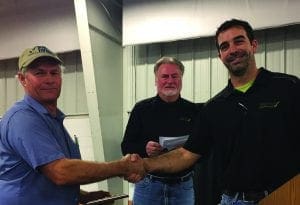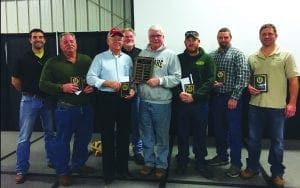 (HARRINGTON, DELAWARE) – January 12, 2017 – John Comegys of Hartly in Kent County, Del., had the state’s top 2016 soybean yield with 80.74 bushels per acre of full season soybeans. Comegys planted Pioneer P36T86R.
(HARRINGTON, DELAWARE) – January 12, 2017 – John Comegys of Hartly in Kent County, Del., had the state’s top 2016 soybean yield with 80.74 bushels per acre of full season soybeans. Comegys planted Pioneer P36T86R.
Kevin Evans of Bridgeville in Sussex County won the statewide double crop competition with 73.51 bushels per acre. Evans planted Pioneer 42T71, a Plenish bean which produces high-oleic soybean oil.
Both men received a check for $1,000. The awards were announced by Delaware Soybean Board chairman James “Jay” Baxter, a farmer from Georgetown, Del., at the annual Ag Week education program in Harrington.
The Delaware Soybean Board is funded by the national soybean checkoff program, which assesses one-half of one percent of the net market value of soybeans at the first point of sale. The funds are collected for soybean research, marketing and education projects.
 County winners for full season soybeans included Robert Garey of Sussex County with 73.52 bushels per acre; Dale Scuse of Kent County with 80.10 bushels per acre; and Robbie Emerson of New Castle County with 66.84 bushels per acre.
County winners for full season soybeans included Robert Garey of Sussex County with 73.52 bushels per acre; Dale Scuse of Kent County with 80.10 bushels per acre; and Robbie Emerson of New Castle County with 66.84 bushels per acre.
County winners for double crop beans included David Smoker of Sussex County with 69.13 bushels per acre and Dale Scuse of Kent County with 62.94 bushels. There was no entry from New Castle County for double crop beans.
County level winners received $250. All entries in the contest were irrigated beans.
Delaware farmers plant about 180,000 acres of soybeans each year, and the crop generates approximately $60 million in value to the state. Delaware’s agricultural industry contributes about $8 billion per year to the Delaware economy.
The Delaware Soybean Board consists of nine farmer-directors and the Secretary of Agriculture, and administers the federal soybean checkoff programs in the state. Under the soybean checkoff, one half of one percent of the net market value of soybeans is assessed at the first point of sale to support research, marketing and education programs to benefit the soybean industry.
Insights after Five Years
A closer look at the production methods, as viewed by Phillip Sylvester, UD Cooperative Extension agent, Kent County.
There were 67 entries in the Delaware soybean yield contest from 2012-2016. Forty-three were entered as full season soybeans while the remaining 24 were double-cropped after a small grain crop.
- Over 93% of the full season soybean entries were irrigated with an average yield of 67.4 bu/A compared to the non-irrigated average yield of 65.4 bu/A.
- Eighty-three percent of the double crop entries were irrigated with an average yield of 62.9 bu/A compared to the non-irrigated entries, which yielded 47 bu/A.
- All the contestants used the herbicide Roundup (active ingredient: glyphosate).
- The majority (72%) used a cover crop in the full season entries, with rye being the most popular followed by wheat, barley, triticale, and hairy vetch.
- 30” row spacing was the most common (49%) in the full season entries with an average yield of 66.8 bu/A followed by 15” (40%) at 67.6 bu/A, and drilled (row spacing less than 8”) (11%) at 68.3 bu/A. The 15” row spacing was most common in the double crop entries (67%) with an average yield of 60.9 bu/A followed by 30” (29%) at 57.7 bu/A while only one contestant used a row spacing less than 8” with a yield of 66.8 bu/A.
- Over the past five years, 100% of the winners in the full season category planted in May while 75% of the winners planted double crop beans in June.
- In 2016, the winning full season soybeans were (80.74 bu/A) planted at 140,000 seeds per acre compared to 148,000 seeds per acre in the double-cropped soybeans (73.64 bu/A).
